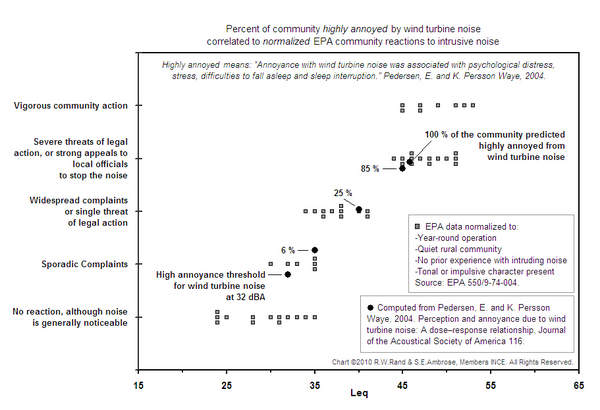| Wind Watch is a registered educational charity, founded in 2005. |
Wind turbine noise: noise complaints predictable
Credit: By Stephen Ambrose and Robert Rand, Herald Gazette, knox.villagesoup.com 30 October 2010 ~~
Translate: FROM English | TO English
Translate: FROM English | TO English
Applicants and regulators should have foreseen the negative noise response from neighbors living near wind turbine sites. By their not adequately understanding the sound character generated by wind turbines, appropriate corrections to prevent annoyance were not included in the noise predictions. Wind turbine noise has a unique and visceral sound character, which may be perceived as being twice as loud as measured.
Community noise studies have shown that public annoyance increases substantially when there is a noise source with unpredictable variability and unusual sounds. The Environmental Protection Agency’s 1974 “Information On Levels Of Environmental Noise Requisite To Protect Public Health And Welfare With An Adequate Margin Of Safety, 550/9-74-004” presents a community reaction prediction methodology, which includes annoyance correction factors for seasonal operation, background sound level, previous experience to the noise and tone.
In 1989 Maine adopted some of the EPA recommendations and chose the 1-hr Leq (average) in lieu of the Ldn (day-night average), along with corrections for tonal and impulsive sound. The Maine Department of Environmental Protection noise limits are stipulated in the Site Location of Development Chapter 375.10 Noise and are applicable when there is no qualified municipal noise ordinance.
Chapter 375.10 recognizes and establishes the Legislature’s intent to control the potential for adverse community reactions in its preamble: “The Board recognizes that the construction, operation and maintenance of developments may cause excessive noise that could degrade the health and welfare of nearby neighbors. It is the intent of the Board to require adequate provision for the control of excessive environmental noise from developments proposed after the effective date of this regulation.”
Community reaction to wind turbine noise can be predicted using the EPA methodology and is normalized for quiet areas and the DEP use of Leq. Correction factors include 0 dB for year round operation, 10 dB for being located in a quiet area, 5 dB for no prior experience and, 5 dB for having a tonal or impulsive sound character. The graph showing normalized EPA community reactions is shown in Figure 1. This graph includes the results of 2004 independent wind turbine annoyance research, “Perception and annoyance due to wind turbine noise: A dose – response relationship,” by E. Pedersen and K. Persson Waye, in the Journal of the Acoustical Society of America. Figure 1 clearly shows that there is a predictable adverse community response for wind turbine noise levels above 32 dBA.
Wind turbine noise levels below 35 dBA may be audible, but will result in the community reactions ranging from “no reaction, although noise is generally noticeable” to “sporadic complaints”. Whereas from 35 to 45 dBA, there is a predicted adverse community response ranging from “widespread complaints or single threat of legal action” to “severe threats of legal action or strong appeals to local officials to stop the noise”. Similarly, the 2004 data predict 6 to 85 percent of the community will be highly annoyed, with the associated adverse health effects of “psychological distress, stress, difficulties to fall asleep and sleep interruption.”
Wind turbine noise levels louder than 45 dBA will result in the highest negative community response of “vigorous community action”. In like manner, the 2004 data predict, “100 percent of the community highly annoyed from wind turbine noise” with the associated adverse health effects already noted.
Other researchers have recommended quieter wind turbine noise levels than the DEP’s current 45 dBA. Dan Driscoll, a recognized acoustic professional, recommended 33 dBA in 2009. The Hayes McKenzie Group recommended 33 dBA in 2006 when the impulsive character is audible. Dr. Michael Nissenbaum, of Fort Kent, conducted an independent medical control study for residents living near the Mars Hill wind turbines, with a recommendation for a minimum separation distance of 7,000 feet. This distance was found by the authors to correlate with wind turbine noise level versus distance measurements for noise levels in the mid- to high 30s (dBA) depending on number of wind turbines and other factors.
If the DEP regulators require developers to account for the noise level variability and tonal sound content in wind turbine noise, they would adjust the 45-dBA-night noise limit lower to a maximum of 35 dBA. This 35 dBA would be consistent with the EPA noise level prediction for no more than “sporadic complaints” and, the Pedersen and Waye prediction for community reaction would be reduced to just above the “high annoyance threshold for wind turbine noise.”

Figure 1 – Percent of Community Highly Annoyed.
Stephen Ambrose and Robert Rand are members of the Institute of Noise Control Engineering. In 2009, they became concerned about the negative comments from residents living near wind turbine sites and, the apparent lack of regulatory action to address the potential for adverse health impacts from wind turbine generator noise in Mars Hill. They launched their own evaluation, and came to the following conclusions in a series of guest columns.
This article is the work of the source indicated. Any opinions expressed in it are not necessarily those of National Wind Watch.
The copyright of this article resides with the author or publisher indicated. As part of its noncommercial educational effort to present the environmental, social, scientific, and economic issues of large-scale wind power development to a global audience seeking such information, National Wind Watch endeavors to observe “fair use” as provided for in section 107 of U.S. Copyright Law and similar “fair dealing” provisions of the copyright laws of other nations. Send requests to excerpt, general inquiries, and comments via e-mail.
| Wind Watch relies entirely on User Funding |
 (via Stripe) |
 (via Paypal) |
Share:

